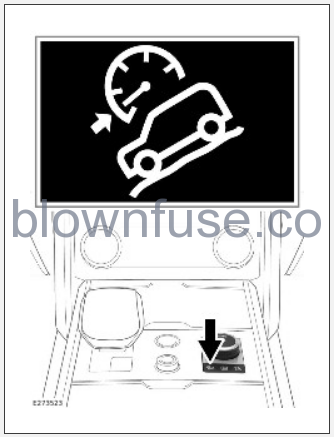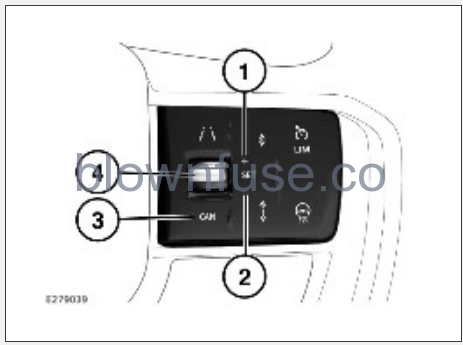 2023 Land Rover NEW RANGE ROVER ALL TERRAIN PROGRESS CONTROL (ATPC)
2023 Land Rover NEW RANGE ROVER ALL TERRAIN PROGRESS CONTROL (ATPC)

ALL TERRAIN PROGRESS CONTROL (ATPC) SAFETY
Make sure the following warnings have been read and fully understood before using All Terrain Progress Control (ATPC). Failure to follow the guidelines could result in vehicle damage, serious injury, or death.
- Use extreme care when maneuvering the vehicle in challenging off-road conditions. The driver must maintain full control of the steering and be prepared to use the brakes at all times.
- Do not attempt a steep descent if ATPC is not enabled, or if the instrument panel displays any warning lamps or messages.
- Do not allow ATPC displays to distract the driver while the vehicle is moving.
ALL TERRAIN PROGRESS CONTROL (ATPC) OVERVIEW
Make sure the relevant safety warnings have been read and understood before using All Terrain Progress Control (ATPC). See ALL TERRAIN PROGRESS CONTROL (ATPC) SAFETY.
ATPC is an aid to off-road driving. When activated, the system attempts to maintain a constant vehicle speed when met with challenging off-road conditions. For example, when traversing snow, grass, gravel, sand, or mud.
Two levels of ATPC are available:
- Descent control mode. See DESCENT CONTROL MODE.
- Full function mode. See FULL FUNCTION MODE.
When ATPC is enabled, and the brake pedal is fully released, the system helps to provide controlled and progressive assistance to allow the vehicle to:
- Pull away from a standstill, in a forward or reverse direction, on level ground, uphill, or downhill.
- Perform low-speed maneuvering in a forward or reverse direction.
- Make progress and maintain a selected speed, up to a maximum of 19 mph (30 km/h).
ATPC also works in conjunction with the terrain response system and applies different acceleration rates based on the selected driving program. For example, the grass gravel snow setting requires the ATPC system to apply gentle vehicle acceleration. The comfort setting requires the ATPC system to apply a greater rate of vehicle acceleration. See TERRAIN RESPONSE OPERATION.
The instrument panel displays warnings and information messages to make sure the full benefits of ATPC are realized.
The cruise control, speed limiter, and auto stop/start systems are disabled when ATPC is operating.
ENABLING ALL TERRAIN PROGRESS CONTROL (ATPC)
Make sure the relevant safety warnings have been read and understood before using All Terrain Progress Control (ATPC). See ALL TERRAIN PROGRESS CONTROL (ATPC) SAFETY.
ATPC can be enabled when the vehicle is stationary or moving. When enabled, the system defaults to descent control mode. See DESCENT CONTROL MODE.

The ATPC button is located on the center console. The ATPC button also controls the operation of the Hill Descent Control (HDC) system. See HILL DESCENT CONTROL (HDC).
The button operates as follows:
- A first press of the button enables the HDC system.
- A second press of the button disables the HDC system and enables ATPC.
- A third press of the button disables ATPC.
The instrument panel displays an information lamp and a message to confirm that ATPC has been enabled. See ALL TERRAIN PROGRESS CONTROL (ATPC) (GREEN).
To enter descent control mode, see DESCENT CONTROL MODE.
To enter full function mode, see FULL FUNCTION MODE.
ATPC remains enabled for 6 hours after the vehicle’s ignition has been switched off.
DESCENT CONTROL MODE
Make sure the relevant safety warnings have been read and understood before using All Terrain Progress Control (ATPC). See ALL TERRAIN PROGRESS CONTROL (ATPC) SAFETY.
Descent control mode attempts to maintain a constant vehicle speed when descending a slope.
To enter descent control mode:
- Carefully position the vehicle at the top of a slope.
- With the vehicle stationary, press and hold the brake pedal.
- Enable ATPC. See ENABLING ALL TERRAIN PROGRESS CONTROL (ATPC).
- Select an appropriate terrain response program. See TERRAIN RESPONSE OPERATION.
- Select Drive (D).
- Release the brake pedal.
ATPC takes control of the vehicle’s speed during the descent. The selected terrain response program determines the vehicle’s speed during the descent. The vehicle’s speed can be reduced by moving the SET switch on the right side steering wheel controls downward.
ATPC suspends descent control mode operation if the accelerator pedal is pressed. Descent control mode resumes once the accelerator pedal is no longer being used.
FULL FUNCTION MODE
Make sure the relevant safety warnings have been read and understood before using All Terrain Progress Control (ATPC). See ALL TERRAIN PROGRESS CONTROL (ATPC) SAFETY.
Full function mode builds on the features available in descent control mode, to further enhance the vehicle’s ability to gain traction in challenging conditions. The benefits of full function mode include:
- Making a controlled ascent.
- Pulling away from a standstill.
- Driving on unstable and slippery surfaces.
Full function mode is only available if the driver’s seat belt is buckled and all doors are closed. The instrument panel displays a warning message if these conditions are not met.
To enter full function mode, first, enable ATPC. See ENABLING ALL TERRAIN PROGRESS CONTROL (ATPC).
The vehicle is now in descent control mode.

To enter full function mode with the vehicle stationary, move the switch (4) up to the SET+ position (1) with the brake pedal firmly pressed.
To enter full function mode with the vehicle moving, move the switch (4) up to the SET+ position (1).
To adjust the vehicle’s speed while full function mode is active:
- Move the switch (4) up to the SET+ position (1) to raise the vehicle’s set speed, or:
- Move the switch (4) down to the SET– position (2) to lower the vehicle’s set speed.
- Press the CAN button (3) to cancel the speed adjustment, and revert back to descent control mode.
- Press the RES switch (4) to resume the set speed, if the vehicle’s speed has been lowered through gentle application of the brake pedal.
The RES switch should only be used if the driver is aware of the set speed and intends to return to it. Pressing the RES switch when not aware of the set speed may lead to a loss of control of the vehicle.
Incremental increases or decreases in the set speed vary depending on the vehicle’s current set speed, as follows:
- 0.3 mph (0.5 km/h) increments if the vehicle’s set speed is between 0 and 3 mph (0 and 5 km/h).
- 0.6 mph (1 km/h) increments if the vehicle’s set speed is between 3 and 6 mph (5 and 10 km/h).
- 1 mph (2 km/h) increments if the vehicle’s set speed is between 6 and 19 mph (10 and 30 km/h).
The minimum set speed is 2 mph (3 km/h).
ATPC reverts back to descent mode if:
- Park (P) or Neutral (N) is selected.
- The Electric Parking Brake (EPB) is applied.
- The brake pedal is firmly pressed.
- The vehicle is brought to a standstill through the light application of the brake pedal.
Light, gentle use of the brake pedal lowers the full function mode set speed. When the brake pedal is released, ATPC maintains the speed at which the vehicle was traveling when the brake pedal was released. A slight pulsation may be felt through the brake pedal when ATPC is actively braking.
ALL TERRAIN PROGRESS CONTROL (ATPC) LIMITATIONS
All Terrain Progress Control (ATPC) does not operate if the following systems are enabled:
- Advanced tow assist.
- Any parking feature.
ATPC may also not operate if a system fault is present.
ATPC operation is disabled if the vehicle’s speed rises above 50 mph (80 km/h). In this event, the ATPC information lamp extinguishes.
ATPC operation is suspended if:
- The vehicle’s speed rises above 19 mph (30 km/h). In this event, the ATPC information lamp flashes. ATPC operation resumes if the vehicle’s speed drops below 19 mph (30 km/h).
- The brake or accelerator pedals are used. ATPC operation resumes when the pedals are no longer being used.
ATPC performance is affected:
- If a fault is present in the system. In some circumstances, ATPC may operate in descent control mode only. In this event, the SET rocker switch on the right side steering wheel controls can be moved upward to increase the descent control mode set speed.
- If the vehicle’s brakes become overheated. ATPC operation is suspended if brake temperatures continue to rise.
The instrument panel displays messages to inform the driver of any performance or system issues.
